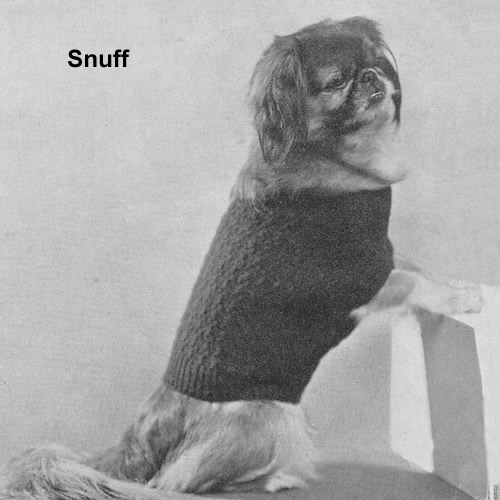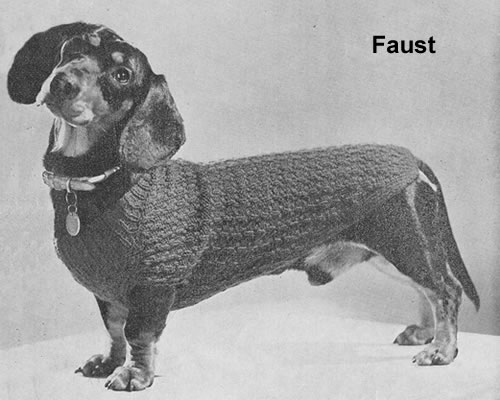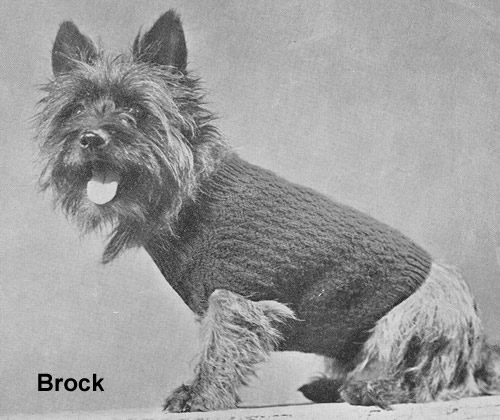A Jumper for your Dog
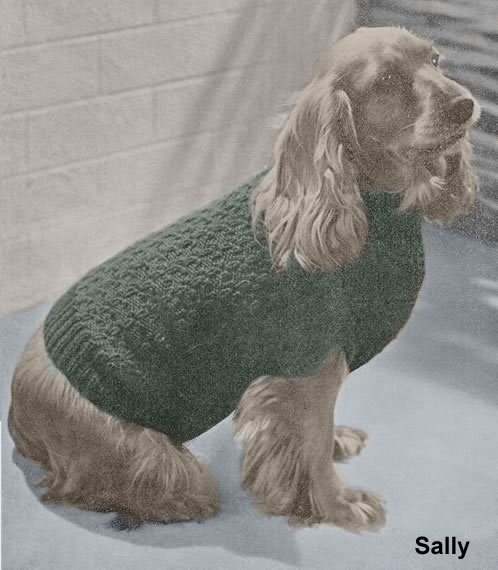
A dog coat which is basically for smaller dogs (which are more likely to need one in colder weather). The pattern is worked out to fit the dogs shown in the photos; Sally, pictured above is the larger size and the other three dogs are shown at the end. Here is the introduction for this 1930s pattern:
Here is a very easy way to keep your dog free from chills during the winter months. Most dogs feel the damp just as much as you do, especially when they are getting on in years, and a nice jumper like this to keep the tummy warm will help to prevent colds and rheumatism. The collar has been made to fit low down as a dog is apt to feel heat easily round the neck.
Instructions.Instructions are given for 3 sizes (large, medium, small) which are named
after the doggy models "Sally", "Snuff",
and "Faust" (see pictures) As far
as I can tell they are a Spaniel, a Pekingese, and a Dachshund. The additional "Brock" seems to be some kind of terrier; his
coat is worked exactly as for Snuff, but you need to knit an extra inch
on the back, so continue until work measures 6 inches from the leg openings
before shaping the back, instead of 5 inches. Pattern rows1st row: *
p3, k1; repeat from * to end. Work up a small piece of pattern before starting to make sure you can follow it correctly when increasing - and perhaps use it to make a swatch to check your tension. Coat (or "Jumper")With No 7 (10) [10] needles, cast on 68 (96) [72] stitches, and work in k1/p1 rib, shaping for neck as follows: 1st row: Rib 18 (24)
[20], turn. Now repeat the all previous 12 rows 3 (2) [3]times. Change to No 6 (9) [9]
needles and pattern stitches as above, at the same time
increasing as follows: Continue in pattern, increasing thus in every row, and taking the extra stitches into the pattern as set, until there are 124 (136) [120] stitches on the needle. (Be very careful to keep the pattern correct over the increasings, and refer to close-up photo.)
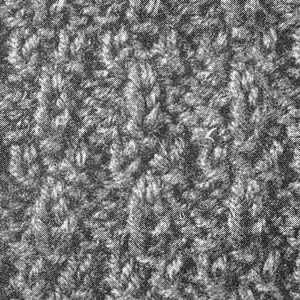
Divide for leg openings: Work 16 stitches in pattern, turn, leaving remaining stitches on a spare needle or stitch holder, and work 4 (3) [3] inches straight. Leave these stitches and work 4 (3) [3] inches straight on the next 92 (104) [88] stitches, and then work 4 (3) [3] inches straight on remaining 16 stitches. Continue in pattern, working across all the stitches again, decreasing
in every alternate row (every row)
[every 4th row] as follows: Continue thus until 100 (100) [116] stitches remain, and then work straight until work measures 7½ (5) [4½] inches from the leg openings. For Sally and Snuff only continue
as follows: Work 1½ (1) inches more in rib
working across all stitches. For Faust only, work as follows: Change to No. [10] needles. 1st row: (k1, p1) 8 times, pattern
the next 84 stitches, (k1, p1) 8 times. Rejoin wool to main work. Now work over all stitches in k1/p1 rib, decreasing at each end of every
row until 36 stitches remain. To Make UpPress main part lightly under a damp cloth, avoiding the ribbing. Join
the two edges together and, if desired, over sew neatly round leg openings. |
Materials5oz Double Knitting for the largest size "Sally", 2oz 4ply
for medium "Snuff" or "Brock", and A pair each of No 6 (9) [9] {5mm (3¾mm) [3¾mm]} and No 7 (10) [10] {4½mm (3¼mm) [3¼mm]} needles. Tension22 (32) [32] sts and 24 (32) [32] rows to 4 inches over pattern. Size mattersAround the neck: 13½ (12) [9] inches; width all round at foreleg: 24 (18) [16] inches; foreleg to back leg at underseam: 9 (6) [6] inches; width all round at back leg: 21 (13) [15] inches; width between forelegs: 6½ (4) [4] inches. A Word on the WoolOriginally these were knitted in Totem and Diana Non-Shrink Knitting Wool. Given the prevalence of wonderfully practical acrylics these days, they would seem to be a good alternative to wool, (and appear in almost any colour you would care to imagine). Disclaimer
|
|
Slide the jumper over your little doggy's head and gently push his little doggy legs through the openings. Say "what a good dog" a few times to avoid distress. I expect he'd like a biscuit too (what a good dog...).Here is some promotional advice from the 1930s: When it turns very cold indeed and these handsome coats aren't sufficient to ward off chills, their cautious owners give them a few extra Spratt's biscuits every day. These contain warming cod-liver oil and are most nourishing. |
|
